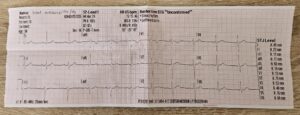Week 4: Slowing Down
Sofia R -
Alright let’s get started.
This week did not go as I hoped. Although nothing went wrong, it was just slow. Overall, I had two calls, and one of them we jumped on just so I can see my first cardiac patient. They ended up being a low acuity call with a failure to thrive. One thing I have seen is how unfortunate some people live, and it has opened my mind. This patient had MS also known as Multiple Sclerosis where the immune system attacks the myelin sheaths of the central nervous system, and it can cause potential disabilities. In this case it did, and the patient was in a wheelchair. They did not have chest pain but had recently been weaker than normal, so they called 911. This call showed me that not all care takers are good. The apartment was messy, with old, dried vomit and urine on the ground, there were medications all over tables and the caregiver did not bat an eye. The patient did not have the best access to healthcare and was not well taken care of. I always thought that people who are hired to take care of someone does their job, but in this case, they barely cared about the patient. With this newfound awareness, I believe more attention should be brought to this as one of the flaws in the American healthcare system.
Even though I did not get many calls I got to learn some new things! I have been continuously studying drug profiles since I have been hearing the same set of medications over and over, and I have gotten a better understanding of what medications are used by the department. The most interesting drug is Adenosine, which is used on patients whose heart rhythms are very fast (tachycardia). If you look at the first image below, each heartbeat is very narrow but even. If the patient is stable, adenosine can be administered. It basically “resets” the heart by temporarily stopping it and restarting it. Once this is done, the hope is that the heart rate will slow down. The image I used to show the narrow rhythm is called a 12-lead. By placing 10 leads on a patient, first responders get different views of the electrical activity occurring in the heart and possibly identify what is wrong. It is not a first responder’s job to diagnose, but this tool is helpful in determining treatment while enroute to a hospital. On one of my rides, the captain of our crew allowed me and the firefighter to do a 12-lead on him, below (image 2) is the rhythm he had, which is a healthy sinus rhythm.
Next week is my spring break and I will not be in town, but after that my project will resume and I hope I will get more learning experiences!



Comments:
All viewpoints are welcome but profane, threatening, disrespectful, or harassing comments will not be tolerated and are subject to moderation up to, and including, full deletion.